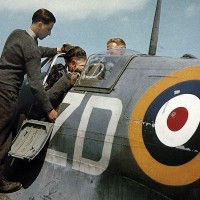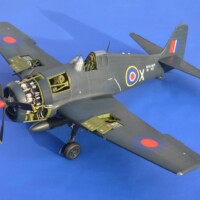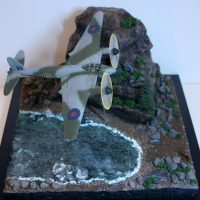Douglas XB-19
Here’s my XB-19 in 1:44 from Anigrand, an all-resin kit. This scale is not my thing, but it’s a B-19, something I’ve wanted since childhood, and so was happy to have one in any scale. Even so, it is a decent sized model. I don’t look forward to masking all those tiny little clear parts on anything like that again any time soon! Anigrand offers some interesting subjects in 1:44 and some in 1:72. The kit comes with 2 other bonus kits in 1:44, a P-59 and XP-46, and a choice of engines, the R-3350 radials, and the Allison XV-3420s for the XB-19A. I wanted the NMF version. I painted the stripes on the rudder and finished the rest with various shades of Alclad.
The specification that produced the first US long range heavy bomber was the top secret US Army Air Corps “Project A” in mid-1933 calling for manufacturers to test the outside limits of the envelope and explore the concept building of a long range heavy bomber
In April of 1934 the US Army Air Corps contracted with Boeing and Martin to design a long range heavy bomber capable of carrying a 2000 lb. bomb load over a distance of 5000 miles at 200 MPH. Boeing responded with their Model 294, or the XB-15. When it first flew in October 1937 it was the largest aircraft ever built in the US and set a number of records for a land-based bomber. However, it failed to reach the desired 200 MPH cruise speed.
The Martin design was a twin-boomed monster with 4 tractor and two pusher engines and was judged inferior by the USAAC before it got off the drawing board and was cancelled.
In mid-1935 the USAAC combined the secret Project A with Project D, asking for the maximum feasible range possible. The combined project was designated BLR, for Bomber, Long Range. The XB-15 was re-designated XBLR-1. It was joined by two other projects under the BLR program, the Douglas design was designated XBLR-2, and XBLR-3 was a Sikorsky design. The Sikorsky design was similar to the XB-19 but was cancelled before any metal was cut. The next year, the XBLR designation was dropped, and the Boeing prototype once again became the XB-15 and the Douglas airplane was designated the XB-19.
The original completion target for the XBLR-2 was 31 March 1938. This proved to an unrealistic goal. One reason was the gigantic aircraft was to be equipped with fully retractable tricycle landing gear- a first for an aircraft of such size and weight. The massive aircraft was to be manned by a crew of 16, with provision for 2 additional flight mechanics and a six-man relief crew. The area above the bomb bay had seats, bunks, and a galley to accommodate the crew on the proposed 24-hour missions. The wings had catwalks inside to accommodate the flight mechanics working on the engines and accessories while in flight.
Another challenge was the powerplants intended for use on the XBLR-2. As originally drawn the aircraft was to be powered by six engines of at least 2,000 horsepower each. By the time construction began the bomber was to be powered by four Allison XV-3420-1 V24 cylinder liquid-cooled engines, the same engine that was originally intended for the Boeing XBLR-1. The XV-3420 was essentially a pair of Allison V-1710 V12 cylinder liquid-cooled inline engines co-mounted and coupled together via a gearbox to drive a single propeller. But on 2 November 1936 Douglas decided instead to use four Wright R-3350 Duplex-Cyclone 18 cylinder air cooled radial engines instead of the Allison powerplants. Delays, delays, delays.
Now designated the XB-19, the big Douglas bomber was finally fully funded on 8 March 1938. Douglas, already working on other designs that would eventually help win World War II, and straining to manage all of the critical work, recognized the limited benefit of continuing work on the XB-19. Douglas actually recommended cancellation of the project, but the US Army wouldn’t quit on the the XB-19. But they did remove the XB-19 from the list of secret projects in 1940. This resulted in quite a bit of attention from the aviation press. A one of a kind monster.
When completed in May of 1941, the XB-19 was a low-winged monoplane sitting on single-wheel tricycle landing gear with a wingspan of 212 feet, wings that were tapered with a straight trailing edge and swept back leading edge, a conventional empennage, and a maximum gross weight of 162,000 pounds. The XB-19 was powered by four nacelle-mounted Wright R-3350-5 radial engines rated at 2000 horsepower each at takeoff, turning three-bladed constant-speed propellers 17 feet in diameter.
The 55 minute first flight of the XB-19, USAAC serial 38-471, took place on 27 June 1941. The enormous bomber was flown from Clover Field in Santa Monica over to March Army Airfield near Riverside so the Army Air Corps could begin evaluating it. Thirty hours of flight test time later, the XB-19 was tentatively accepted in October of 1941.
It wasn’t until numerous modifications, including the addition of improved brakes were accomplished that the Army Air Corps formally accepted the XB-19 in June of 1942. With the exception of engine cooling challenges, which required the engine cooling flaps be kept open during long flights, resulting in a 20 mile per hour reduction in maximum speed at 15,700 feet, the XB-19 proved to be relatively trouble-free during subsequent test flights.
The attack on Pearl Harbor on December 7, 1941 necessitated some changes. The XB-19 was painted in olive drab over gray camouflage, its defensive armament was installed, and only four more test flights were conducted at March Field before the aircraft moved to Wright Field in Dayton, Ohio on 23 January 1942.
Ironically after the the XB-19 completed its flight testing in 1943 it was fitted with four 2600 horsepower Allison V-3420-11 turbo-supercharged twenty-four cylinder liquid cooled engines turning four bladed propellers 19 feet in diameter. These engines were the production version of the engine that had originally been specified for the aircraft. After the engine mods the designation of the aircraft was changed to XB-19A. The XB-19A’s maximum speed rose by 50 miles per hour to 275 miles per hour- still far slower than that of the B-29 and the eventual B-36. The XB-19A was then modified for use as a cargo carrier and flew critical war materiel back and forth across the country for the duration of World War II, joining it’s Boeing counterpart, the XB-15, in similar duties.
The XB-19A made its last flight on 17 August 1946 when it was flown from Wright Field to Davis-Monthan Field in Arizona and placed in storage. The B-36 had flown for the first time nine days earlier.
Although the XB-19A was scrapped in 1949, its nose section inexplicably showed up in a scrap yard on Alameda Street in Los Angeles, where it remained visible until as late as 1955.
In early 1949 the U.S. Air Force had plans to save the B-19 for eventual display, but at the time the Air Force had no program to save historic aircraft and the Air Force Museum had not yet been built. But although the aircraft was scrapped, two of its enormous eight-foot tall main landing gear tires were saved. One was put on display at the Hill Aerospace Museum at Hill Air Force Base. The other has been on display at the National Museum of the United States Air Force for many years.



















Very nice, @chasbunch. I particularly like the paint work. A great result.
Agree with Tom
Holy sheet metal that is a big beauty. I myself have always liked that big bird. Helluva NMF on that.
Super build & NMF. Is that a Lincoln car next to that mega wheel? TC probably knows.
I'm about 90% "yes" on that being a Lincoln.
The XB-19A was also used by the All-Weather Flying Service ( also known as Center) in Thunderstorm research. I have included a profile...
Bruce
1 attached image. Click to enlarge.
That’s really sharp! Great metalwork.
Adorable work! That's a really wonderful outcome on a model seldom to be seen!
Really good result, Chas @chasbunch
Especially the NMF looks amazing.
Well done.
Excellent result on this challenging kit, Chas!
Congratulations!
Excellent work... what did you use for paint or is that Bare Metal Foil?
Thanks, Dan. It's Alclad II - several different shades.
Nice work - a great-looking finish on that.
Beautiful work on the NMF and an excellent job on this build!
Chas this looks really well done, love the outdoor pics.
Rod
Beautiful job on the finish, Chas (@chasbunch). I never knew it actually had an active career flying important material around the USA. Thank you for sharing the model and the info.